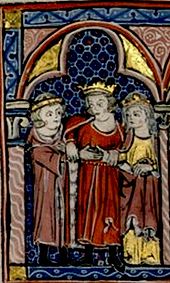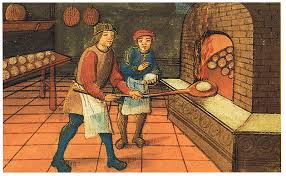As the consort
of Queen Isabella of Jerusalem from May 1192 until September 1197, Henry of
Champagne was recognized by the High Court of Jerusalem and by all his
contemporaries, domestic and foreign, as the rightful King of Jerusalem ― yet
he preferred to call himself the Count of Champagne to the day he died. We can
only speculate on whether that preference sprang from humility or a failure to
identify with his adopted kingdom. Certainly, Henry of Champagne came to the
throne unexpectedly and with little preparation, and had he lived longer, he
might well have come to feel more comfortable in his role as King of Jerusalem.
But his life was cut tragically short in an accident at the age of 31.
His reign started auspiciously. His
first act as King of Jerusalem appears to have been to persuade his uncle the
King of England to remain through the campaign season rather than depart for
England at once. As a result, the crusading army was kept together long enough
for a second (albeit equally unsuccessful) attempt on Jerusalem.
Richard of
England then set his mind to regaining the coast between Tyre and Tripoli, a
clear means of strengthening Henri’s new kingdom, but Saladin’s sudden assault
on Jaffa forestalled him. Richard immediately took a handful of knights in a
few ships and set off for Jaffa to stiffen the defense long enough for relief
to come by land.
Henri meanwhile mustered the Army of Jerusalem and
started down the coast to relieve Jaffa. When the army found its advance
blocked just south of Caesarea by Saladin’s forces, however, Henri followed his
uncle’s example and took ship with just a few men for Jaffa ― abandoning his
army. It was not a particularly regal or strategic thing to do, but Henri
appears to have gotten away with it. The relief of Jaffa was eventually
successful, and his ignominious behavior at Caesarea was forgotten.
A
month later, a truce had been signed with Saladin lasting three years and eight
months or until April 1196. Richard Plantagenet was free to return to his
besieged inheritance in the West, taking with him not only the bulk of the
crusaders but the enormous shadow he had cast over Henri. Henri was at last in
a position to show his merit as a king.
Unfortunately, Henry stumbled at once. Almost immediately after Richard’s departure,
the Pisans started attacking shipping going to Acre. Whether this was
state-piracy or instigated by the still-embittered deposed-King Guy de Lusignan
is not clear. In any case, Henri blamed the Pisan Commune in Acre of abetting
their countrymen, and when Aimery de Lusignan, the older brother of Guy,
defended the Pisans, Henri saw a Lusignan plot against him. He ordered Aimery
de Lusignan arrested for treason.
This only had the effect of angering Henri’s
vassals and the Masters of both the Knights Templar and the Knights of St.
John. Aimery de Lusignan, unlike his younger brother Guy, had been in the Holy
land for nearly two decades by this point and he enjoyed the respect of his
peers. He had been appointed Constable of the Kingdom by Baldwin IV, long
before the catastrophe of Hattin. Furthermore, and most important, the
King of Jerusalem did not have the right to arrest the Constable ― only the
High Court did. Henri was forced to back down, but Aimery (not
surprisingly) did not want to remain in a Kingdom ruled by a man who had
arrested him unjustly. He surrendered the office of Constable and went to join
his brother on Cyprus.
Henry’s
next known act is considerably more to his credit. Sometime during the truce
with Saladin ca. 1195, King Leo of Armenia seized Prince Bohemond of Antioch
during a state visit in revenge for a similar incident years earlier. He
demanded the surrender of Antioch to Armenia. Prince Bohemond ordered the
surrender (to secure his own release), but the citizens of the city led by his
own sons and the patriarch refused to follow his orders.
Instead they sent to Henry of Champagne to negotiate the release of the Prince
of Antioch on more reasonable terms. Henri appears to have carried out this
diplomatic mission successfully, arranging that an Armenian princess marry
Bohemond’s heir.
On
his return trip, Henri traveled via Cyprus, where Aimery de Lusignan had not
only succeeded his brother as lord of the island but persuaded the Holy Roman
Emperor to make him a King. Meeting now as equals, the two men were reconciled,
and to symbolize their new friendship (and secure the future of their houses)
they agreed that Aimery’s three sons should be betrothed to Henri’s three
daughters by Isabella of Jerusalem.
Henri
then returned to his own Kingdom as the truce with the Saracens drew to a close.
Saladin had meanwhile died and his brother al-Adil had successfully eliminated
Saladin’s eldest and second sons to seize power for himself in Damascus and
Cairo. As the truce ended, he took a large force to attack Acre, evidently
seeking to bolster his popularity and support by delivering a victory against
the Franks.
Champagne went out to meet al-Adil with a force composed primarily of German crusaders,
who had since arrived in the Holy Land in anticipation of the end of the truce,
and the knights and barons of Jerusalem. These proved insufficient to defeat
the threat, and Champagne had to call up the commons as well, who then managed to
thwart the invasion and send al-Adil back across the border. Little is really
known about this engagement, but the Lyon Continuation of William of Tyre gives
the entire credit for this victory to a local baron, Hugh of Tiberius, with Champagne simply taking advice. While implausible as written, the account may be
indicative of a general feeling among the local barons that Champagne was not a
terribly effective battle commander, certainly not comparable to his famous
uncle Richard the Lionheart.
His
death, however, may have contributed to this retroactive assessment of him. On
September 10, 1197 Henry of Champagne accidentally fell from a window into a
courtyard of the royal palace at Acre and broke his neck. There was no question
of foul play. One version says he stepped backwards into the window and lost
his balance. Another says he leaned out of the window and the railing gave way.
Apparently his jester, a dwarf, either tried to stop him and also lost his
balance, or flung himself after him in grief. Either way he allegedly landed on
top of Champagne, ensuring his injury was fatal.
Henry of Champagne
left behind three young daughters, the eldest of which died young, and the
second of which, Alice, became Queen of Cyprus in accordance with the agreement
he had made with Aimery de Lusignan.
He also left behind an ugly law-suit.
Since he had never returned from the Holy Land, his brother Theobold laid claim
to the County of Champagne and his sons after him, but Henri’s surviving
daughters, Alice and Philippa, challenged their cousins' claim. They argued that
as the daughters of the elder son (Henry) they were the rightful heirs to
Champagne.
In an effort to negate Alice and Philippa’s (very valid) claim, Theobold’s sons attempted to argue that Henry’s marriage to Isabella had been bigamous, thereby making his cousins Alice and Philippa illegitimate. The reasoning was that Isabella’s divorce from her first husband Humphrey de Toron had been bogus and so she was still married to him (since he was still alive) at the time of her marriage to Henry. This claim was spurious and never accepted by the courts, but it colored the chronicles (all written in France). As a result, this court case has left lasting legacy of distorted historiography, which casts Isabella’s divorce from Toron is a lurid light and makes villains of all who supported it -- from Henry himself to Isabella's mother, Maria Comnena, and her step-father Balian d'Ibelin.
In an effort to negate Alice and Philippa’s (very valid) claim, Theobold’s sons attempted to argue that Henry’s marriage to Isabella had been bigamous, thereby making his cousins Alice and Philippa illegitimate. The reasoning was that Isabella’s divorce from her first husband Humphrey de Toron had been bogus and so she was still married to him (since he was still alive) at the time of her marriage to Henry. This claim was spurious and never accepted by the courts, but it colored the chronicles (all written in France). As a result, this court case has left lasting legacy of distorted historiography, which casts Isabella’s divorce from Toron is a lurid light and makes villains of all who supported it -- from Henry himself to Isabella's mother, Maria Comnena, and her step-father Balian d'Ibelin.
Henry
de Champagne is a significant character in “Envoy of Jerusalem,” where his
relationship to Isabella is developed and examined.



















